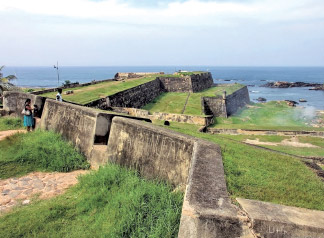Resplendent Galle
by Sumana Saparamadu
|

The ramparts which protected the Galle Fort is still to be
seen
|
|

Galle Light House |
|

Butterfly Bridge |
Galle is a very old town. It has a longer history than that of Kandy
or Colombo. Galle is mentioned in the Kokila Sandesa, a poem written in
Sinhala in the 15th century.It has a beautiful natural harbour. As it is
situated midway in the Indian Ocean, Arab , Chinese and South Indian
traders came in their ships to Galle centuries ago to exchange their
goods. An old stone inscription in three languages - Persian Chinese and
Tamil - was found in Galle.
|

Entrance to the Galle Fort |
|

VOC emblem carved above the entrance |
|

Galle Harbour |
The Portuguese came to Sri Lanka at the beginning of the 16th
century. They first landed in Galle and settled down there. They built a
small fort in 1588. The Dutch came in 1640 and made Galle their
headquarters. They pulled down the fort the Portuguese had built and put
up a huge fort that stands to this day. We know exactly how old this
fort is. The year 1661 is carved on the emblem above the entrance to the
Fort. The three letters VOC stand for Verenigde Oostindische Compagnie.
They are Dutch words meaning Dutch East India Company.
The Dutch had their homes in the Fort. Road names such as Leyn Baan
have come down from Dutch times. Now too there are residences, a school,
a hotel and a church and many shops.The ramparts (walls of the fort)
give Galle her special look. No other town in Sri Lanka has anything
like this. It is a tourist attraction. Galle residents enjoy taking a
walk along the ramparts in the evening. So do locals visiting Galle for
the first time.
A fort always has a moat around it. The Galle fort had a moat only on
one side. The sea was a natural moat on the other sides. The moat was
filled and levelled a long time ago. It is now Galle's esplanade. It was
once a football field.
It is now the venue for national and international cricket matches.
People sit on the ramparts and watch the matches.The Butterfly Bridge
over the Dutch canal is one of Galle's landmarks. It is called Moda Ela
- Foolish Bridge. Why I do not know. Readers in Galle schools are sure
to know. There is a statue of Anagarika Dharmapala near the bridge,
facing the railway station. Before the Colombo harbour was built, Galle
was the main port of call for ships.
The ship that brought Colonel Henry Steel Olcott to Sri Lanka berthed
in the Galle harbour on May 18, 1880. He became a Buddhist - reciting
the Tun Sarana and promising to observe the first precepts - at the
Wijayananda Pirivena in Weliwatta, Galle, the day after he landed in
Galle.The lighthouse is another landmark in Galle. The first light house
built in Lanka was built in Galle.
What we see today is not the former lighthouse. It was a wooden house
burnt down in 1930. The present one was built on the same spot. The
clock tower on the ramparts is yet another landmark. It was built in the
late 1870s.Galle has many schools. Some of them were started by
Christian missionaries in the second half of the 19th century.
Mahinda College was started by Buddhist philanthropists after Col.
Olcott arrived.
The only school I know that is named in honour of him Olcott College
is in Galle.Although Galle is by the sea there are hillocks here and
there in Galle and schools have been built on them - Rippon and
Richmond, Mahinda and Aloysius, the last on a hillock within sight of
the sea.
The distance from Colombo to Galle is 72 miles (106 km) and the town
is connected to Colombo and Matara by road and railway. Galle is the
fourth largest town in Sri Lanka. |


